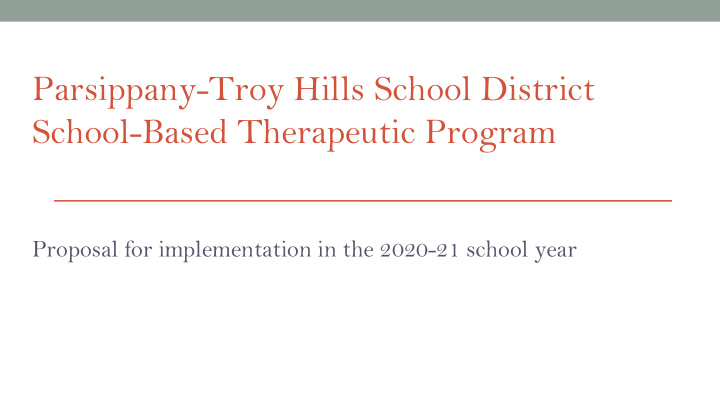



Parsippany-Troy Hills School District School-Based Therapeutic Program Proposal for implementation in the 2020-21 school year
Our Challenge The district is experiencing an increasing number of students with depression, anxiety, and other mental health needs. For many of these students, these mental health issues are significantly interfering with their education, resulting in truancy, failing grades, home instruction, and early drop-out.
Student Crisis Data Number of students sent for Mental Health Clearances 2018-2019 School Year 2019-2020 School Year to Date Elementary 7 Elementary 6 Middle 28 Middle 13 High 25 High 18 District Total 60 District Total 37 * Chart is not indicative of the number of screenings conducted at the district level, but rather, the actual number of students requiring clearance to return. **Does not include students sent for clearance to their own mental health providers.
Our Commitment • The district remains focused on improving mental health outcomes for students. • Provide support for elementary/middle school students with emotional, mental, and behavioral health issues. • Maintain the current intensity of programming for our most at- risk students with experienced and qualified clinicians. • Establish a program to support Tier Two students who require less intense levels of care.
How do we currently support these students? Effective School Solutions ❏ An outside vendor provides four (4) licensed mental health clinicians to PHHS, PHS, and CMS to service identified students. ❏ Supporting 34 students in PHS, PHHS, and CMS. ❏ Currently 5 students at CMS, 19 students at PHS, and 10 students at PHHS. ❏ $509,390 annual contract ❏ 1 Individual or family psychotherapy session/week ❏ 1 daily group therapy (not to exceed 11 students) ❏ 1 multifamily group therapy per month ❏ Daily “Learning Strategies” class taught by our PTHSD teachers.
Challenges of the Current Program ❏ The district is bound by certain ESS procedures and policies that often prevent students from receiving support. For example, the contract allows for nine (9) students per clinician and ESS has sole discretion over which students are admitted to the program. ❏ Students are often in ESS for multiple years ❏ ESS advertises that a student’s tenure is around 2 years. This is significantly higher for PTH students. ❏ Lack of district/CST oversight ❏ Students classified with emotional needs present unique challenges as we look to support them emotionally and academically. ❏ Would benefit from a stronger link between academics and counseling.
Proposal ❏ Hire four (4) additional School Psychologists/Licensed Social Workers. ❏ Establish a class for students with Behavioral Disabilities at the middle and high school level. (STRIVE is our elementary program.) ❏ Establish parameters for identification, progress monitoring, and academic support. ❏ Identify an internal transfer to provide for Tier II support. This provides for four (4) professionals allocated to the In District Therapeutic Program and one (1) professional to initiate a Tier Two Support System.
Proposal ❏ Middle School ❏ Offer a full-day behavioral disabilities program ❏ Connect intensive counseling with academic support ❏ Assign a Social Worker/School Psychologist to develop a Tier Two program ❏ High School ❏ 1 Individual or family psychotherapy session/week ❏ 1 daily group therapy (not to exceed 11 students) ❏ 1 multifamily group therapy per month ❏ Learning Strategies class to provide academic support ❏ Team approach when working with students ❏ Provide clinician oversight for students/families regarding Care Management, Intensive Out-Patient, and Partial Hospitalization. ❏ Develop a Tier Two program of support
Next steps and decisions • Communicate with families on a personal level through IEP and counseling meetings about next year’s services. • Hire professional staff experienced in clinical work with adolescents and teenagers. • Include current ESS students/parents in the interview process. • Review recommendation procedures and develop roster of students for 2020-21, with the full understanding that students may continue to be recommended throughout the year. • Plan for summer transition ~ • Consider ‘shadowing’ with current ESS if permitted. • Relationship-building meetings.
Recommend
More recommend